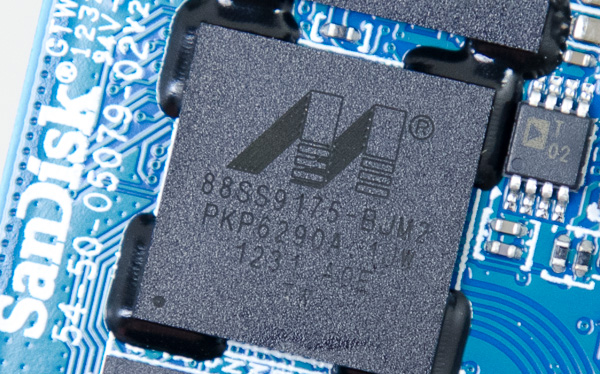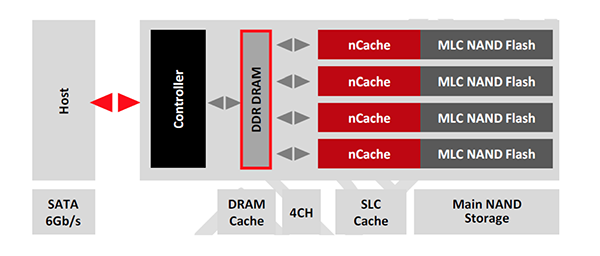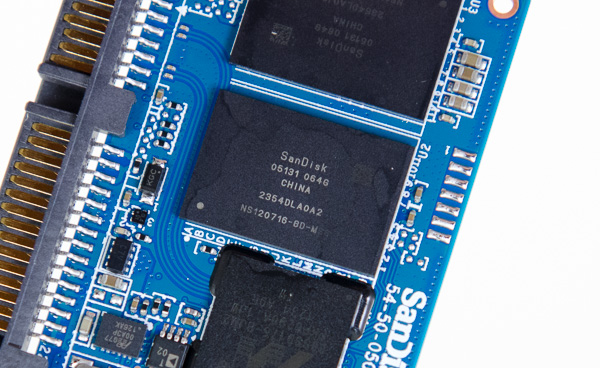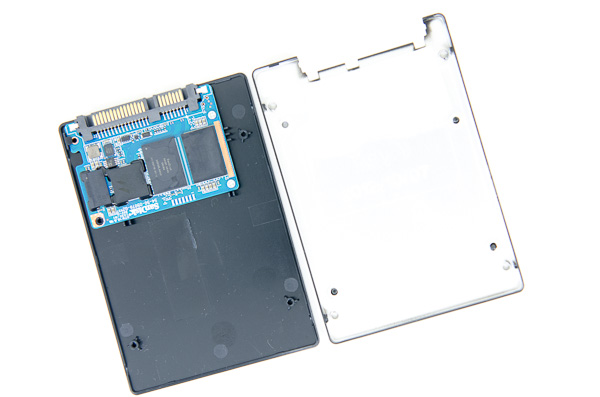SanDisk Ultra Plus SSD Review (256GB)
by Anand Lal Shimpi on January 7, 2013 9:00 AM ESTSanDisk is a household name as far as NAND storage is concerned. You can’t walk into an electronics retailer and not be bombarded with SanDisk made CompactFlash and SD cards. Rip open a tablet and you might find a SanDisk solution. Even the new $249 Cortex A15 based Chromebook uses a SanDisk iNAND device on-board. Similar to Intel/Micron, SanDisk and Toshiba jointly develop and manufacture their own NAND.
The brand is well known and its products are prevalent throughout the OEM space, but in retail SanDisk isn’t as strong as some of its competitors. Recently SanDisk has been hoping to change this with the release of several of its own branded SSDs: the SanDisk Ultra (SF-1200) and SanDisk Extreme (SF-2281).
Like many other SSD companies once married to SandForce, SanDisk also looked elsewhere for controllers. And like many of those same companies, SanDisk ended up at the same place: Marvell.
Today SanDisk is announcing the Ultra Plus SSD, based on Marvell’s SS889175 6Gbps SATA/NAND controller. We’re more familiar with the SS889174 as it’s used in drives like Plextor’s M3 and Intel’s SSD 510. The 9175 is apparently a light version of the 9174, with a big focus on reducing power consumption. The controller (or at least its implementation in the Ultra Plus) features four independent NAND channels, perhaps a key to its low power consumption.
Marvell is a lot more affordable to integrate than SandForce, plus you get direct access to firmware source and the ability to develop your own from scratch; SanDisk’s choice here makes obvious sense.
The Ultra Plus uses SanDisk’s own 19nm eX2 ABL MLC NAND. This is 2-bit MLC NAND with a twist: there’s a portion of the NAND array that operates in an SLC or pseudo-SLC mode. SanDisk calls this its nCache, and the firmware can define how much of the NAND is used as an nCache. Given that the drive appears as a binary capacity to the OS, I’m assuming the total space used as the nCache fits within the ~7% spare area the firmware gets by default.
Small file writes are sent to the nCache to keep performance high, and idle time garbage collection likely dumps the nCache out to the much larger MLC array. The nCache was typically used as a way around having to use DRAM for data structure storage, but in the case of the Ultra Plus you get both: nCache + DRAM. I’m not sure there’s enough of an nCache in the Ultra Plus to make a big enough difference to justify the decision in this case.
SanDisk sent us a 256GB Ultra Plus, which was equipped with 128MB of Samsung DDR2-800 DRAM in a single package. There are four SanDisk NAND packages on the extremely small PCB (64GB per package, 8 x 8GB die per package).
The MSRPs SanDisk quoted us seem relatively competitive with other value drives on the market today:
| SSD Pricing Comparison - 1/6/13 | |||||
| Total System Power | 60/64GB | 120/128GB | 240/250256GB | ||
| Corsair Neutron | $120 | ||||
| Corsair Neutron GTX | $135 | $230 | |||
| Intel SSD 335 | $78 (SSD 330) | $125 (SSD 330) | $180 | ||
| Plextor M5 Pro | $125 | $210 | |||
| Plextor M5S | $50 | $108 | |||
| Samsung SSD 840 | $100 | $180 | |||
| Samsung SSD 840 Pro | $100 | $140 | $250 | ||
| SanDisk Extreme | $114 | $210 | |||
| SanDisk Ultra Plus | $75 | $110 | $220 | ||
At the lower end of the market it’s tough to be significantly cheaper than the competition without a full process node advantage. SSD prices can be very volatile so you’re more likely to see these prices range a bit depending on supply in the channel and whatever rebates may be offered. These numbers at least tell us where SanDisk is aiming in the market.















38 Comments
View All Comments
Flunk - Monday, January 7, 2013 - link
If you want real performance you could make a versio of this that features two of these PCBs along with a RAID chip for enhanced performance. All in a 2.5" form factor would be quite compelling.bmgoodman - Monday, January 7, 2013 - link
Sorry, but after the way SanDisk handled the TRIM issue on their SanDisk Extreme hard drives last year, I will NEVER buy from them again. I understand mistakes are made and things don't go as expected, but for the longest time they simply would not comment at all on the problem. Their response plan to bury their heads in the sand is NOT a strategy for good customer support.Quoth the raven, "nevermore!"
magnetar - Monday, January 7, 2013 - link
IMO, SanDisk handled the SandForce 5.0 firmware TRIM issue as it needed to be dealt with, carefully and professionally.The weak statement about it from a SanDIsk forum moderator that was buried in a thread started by a SanDisk customer was apparently missed by most of those concerned about this issue. That was a mistake. Responding to angry demands for a release date is not professional.
The other SSD manufactures that provided the fixed firmware very quickly were not doing their customers a favor. That indicated to me that those manufactures did very little testing and verification of the new firmware. Considering that all the SSD manufactures that used the 5.0 firmware, and SandForce itself missed finding the problem, a careful approach with the new firmware was warranted.
The firmware update SanDisk provided not only included the fixed firmware, but other fixes as well, including a fix for the incorrect temperature reading some of the Extreme SSDs had. SanDisk chose to provide one update with multiple fixes, rather than multiple firmware updates, which was the better option IMO. The more firmware updates necessary, the less professional the product is.
The R211 firmware update program SanDisk provided was the best one I've ever used. Running in Windows, it worked with the SanDisk Ex connected to the Marvell 9128 SATA chipset! Any other firmware update programs can do that? The lack of complaints about that firmware update program in the SanDisk forum also indicates how good it is.
No blemish on SanDisk IMO, actually exactly the opposite.
Kevin G - Monday, January 7, 2013 - link
Looking at the PCB for this drive makes me feel that this was a precursor to an mSATA version down the road. Hacking off the SATA and power connector for an edge connector looks like it'd be the right size. Kinda makes one wonder why they just didn't using a mSATA to SATA adapter in a 2.5" enclosure and launch both products simultaneously.Kristian Vättö - Monday, January 7, 2013 - link
SanDisk X110 was launched alongside the Ultra Plus, which is essentially an mSATA version of the Ultra Plus.perrydoell - Tuesday, January 8, 2013 - link
How about making the PCB 4x larger... 1GB SSD drive!vanwazltoff - Monday, January 7, 2013 - link
most companies purposely put out a high performing ssd and a low performing ssd, this probably their low end or more likely they are trying to shrink power consumption and size for smaller form factors such as tablets. sandisks extreme ssd went toe to toe with an 830 and proved itself a worthy component with more leveled results than an 830. i am sure they will have answer to the 840 pro soon enoughDeath666Angel - Monday, January 7, 2013 - link
The Extreme was a normal SF-2281 offering with Toggle Mode NAND. Nothing fancy about that imho.iaco - Monday, January 7, 2013 - link
64 GB packages. Verrrry nice.Tells me what we've known all along: Apple has no excuse charging obscene prices for NAND on their iPads, iPhones and Macs. 64 GB probably costs what, $50 at retail? Apple wants $200 to upgrade from 16 to 64 GB.
Maybe they'll finally get around to updating the iPod classic.
Kristian Vättö - Monday, January 7, 2013 - link
8GB 2-bit-per-cell MLC contract price is currently $4.58 ($0.57) on average according to inSpectrum. That would put the cost of 64GB MLC NAND to $36.50. Price depends on quality, though, but smartphones/tablets in general don't use the highest quality NAND (the best dies are usually preserved for SSDs, the second tier NAND is for phones/tablets).